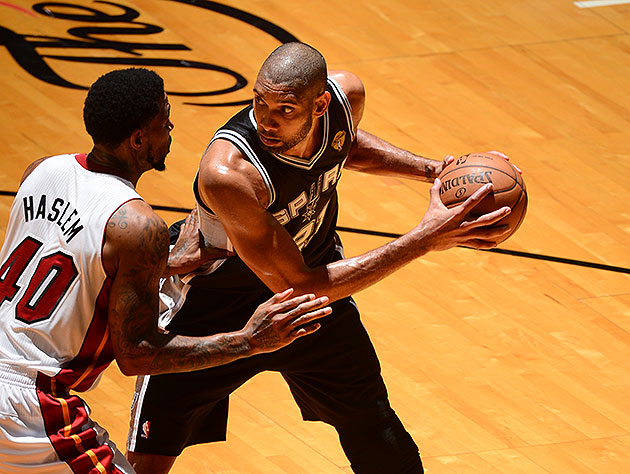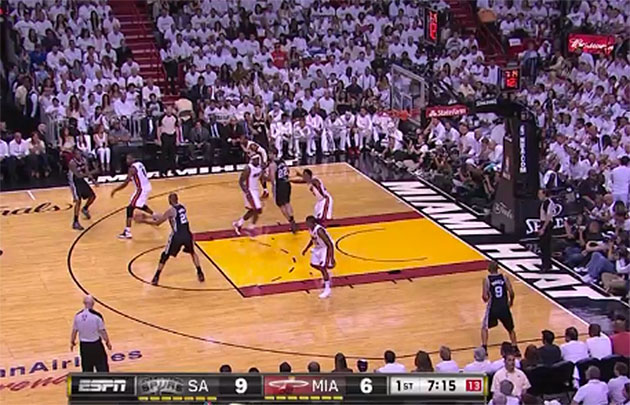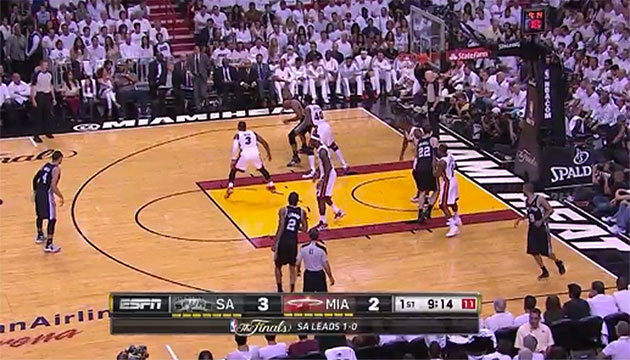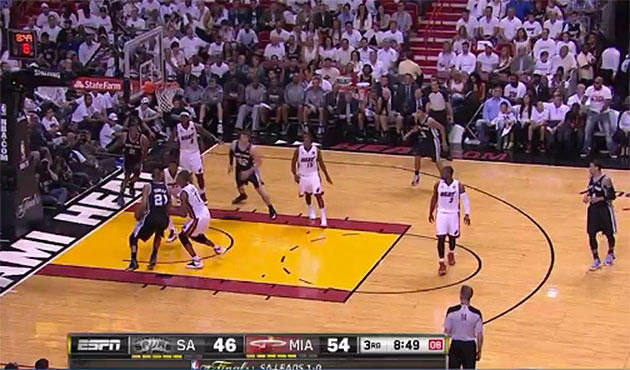
The San Antonio Spurs enter Tuesday's pivotal Game 3 of the 2013 NBA Finals having accomplished their primary goals — taking a game off the Miami Heat at AmericanAirlines Arena and getting back to Texas with a chance to win a championship on their own home floor. To do so, though, they're going to need a significantly better effort than they mustered in Game 2, where sloppy half-court defense and too many turnovers spelled doom for San Antonio, as the Heat put together a dominant second-half run behind withering pick-and-roll work and high-pressure defense.
They'll also need much better performances from their Big Three, as the trio of Game 1 hero Tony Parker, legendary big man Tim Duncan and sixth man extraordinaire Manu Ginobili turned in a collective stinker the likes of which Spurs fans have rarely seen over the years. But despite being held to just nine points on 3-for-13 shooting, Duncan didn't despair on Sunday night — considering the circumstances, he actually seemed fairly chipper.
"I look at my shots and they are the shots I want — obviously, they're contested shots, but they're the shots I feel I can make," Duncan said after Game 2. "So whether it be them or me or whatever it may be, I'm going to get back in the gym tomorrow and hopefully come out with a better stroke. But I'm getting the shots I want. I just have to knock them down."
A closer look at those 13 attempts reveal that, as a matter of fact, Duncan's telling the truth, which could be good news for Spurs fans moving forward. Let's dig in:
Duncan's surprising struggles have been especially egregious in the area along the left block. The 37-year-old big man hit just less than 41 percent of his jumpers from that neighborhood during the regular season and just over 44 percent of his tries through the first three rounds, but has gone empty in six attempts through two games in the Finals.
So what's going on when Duncan looks for the ball on the block? Well, first off, whichever Heat defender is tasked with checking him — primarily Udonis Haslem, through Chris Bosh and Chris Andersen have also seen their fair share of time against him — looks to front him, digging their hip into Duncan's leg to prevent him from getting between the defender and the ball for an easy entry pass. Sometimes just remaining active and staying with the front can scuttle a possession, as was the case with Bosh's work on this try from the first quarter of Game 2:
But the front can also be beaten with effective ball and player movement. On this possession, Parker sees Haslem fronting Duncan and immediately swings the ball back to the top of the key to Kawhi Leonard, who runs a high pick-and-roll with frontcourt partner Tiago Splitter. As Splitter dives to the rim, Duncan pops out to the top of the key:

... and gets an in-rhythm jumper, which he promptly cans:
Another popular strategy for beating fronts is for the entry passer to try to lob the ball over the top behind the fronting defender, but that's made more difficult when the on-ball defender on the entry passer plays up on the ball and much more dangerous when there's an active, ball-hawking back-line defender on the back-side of the play. The Heat have both of those — Dwyane Wade up on Danny Green's pass and LeBron James behind the play — on Duncan's first attempted post-up of the game, so Green goes with the safest pass he can make and just dumps it in to Duncan near the baseline.
Green then flows through to the right side of the floor, where he joins Parker, Leonard and Splitter in clearing out left for Duncan to go one-on-one with Haslem. Duncan tries to get to the middle of the floor, looking to draw help and find to an open shooter, but the Heat are in good position to take away any kickouts (save, perhaps, one to Parker in the far corner, but that's a really tough pass to make if you're not LeBron):

Haslem maintains good body position on Duncan to keep him from getting to the heart of the lane for his own look, which leads Duncan to roll back to his right toward the baseline and fire a 14-foot turnaround fadeaway. Haslem stays with him the entire way and keeps a hand in Duncan's face, and Duncan misses:
Makeable? Sure. But turnaround fadeaways with a hand in your face aren't exactly high-percentage looks. That's probably why the Heat didn't mind it when Duncan took another one against Birdman later on in the game:
In situations like that — an early catch, a not-quite-ready-to-roll rotation behind him — Duncan needs to attack Birdman and head right to the basket. The hesitation as he gathered allowed Andersen to set his feet and the back-side help to key in, removing the quick spin or strong drive as attractive options and making the turnaround seem like a better play than it really was.
Duncan got a better entry on his second post touch of the game — which didn't come until several minutes into the third quarter — thanks to a neat little cross-screen from Leonard that kept Bosh from being able to cleanly front Duncan. But the Heat's help was better, too, in part because of less-than-ideal San Antonio spacing.
After Duncan gets the entry pass from Cory Joseph and begins to work on Bosh, Splitter stays right under the basket and Leonard cuts from the top of the floor into the lane. With Chalmers not too worried about a fresh-off-the-bench (and not that threatening anyway) Joseph, Duncan's driving into a world of white:

... which results in a miss, although Leonard does get the put-back:
Two other Duncan left-block post-ups, though, fell closer to Duncan's "the shots I want" framework — one off a baseline out-of-bounds play in the third quarter (which he may have rushed a bit with the shot clock winding down):
And another two possessions later, where Duncan's trademark banker came up empty:
One common thread you might have noticed on many of those low-block misses: the defense of Haslem, who, statistically speaking, appears to be having quite the dampening effect on Duncan.
Through two games, Duncan has just six points on just 3 for 16 shooting during 32 minutes with Haslem on the floor, compared to 23 points on 8 for 16 shooting in 34 minutes with Haslem on the bench. He also hasn't taken a free throw in those 32 Haslem minutes, compared with a 7 for 8 mark from the charity stripe in 34 minutes with the Heat bruiser sitting.
Haslem swears there's no secret to defending Duncan, though, according to CBSSports.com's Matt Moore: "Really there was nothing in the film that said 'OK, let me take away this.' It's really just a matter of competing and contesting everything, and then accepting backside help when I need it."
Of course, it's awful nice when the help is this active:
(To be fair, the Spurs got the Heat back on one of these wraparound feeds later for a Timmy dunk. It's nice for the offense when the help defender's a step-slow Chalmers rather than an in-the-air LeBron.)
Duncan seemed to get pretty solid looks when working as a screener, too, whether catching in the middle of the floor with a chance to drive:
Or at the elbow/on the wing when popping off a side screen-and-roll:
... but he just kept coming up empty.
While revisiting all those bricks is probably frustrating for San Antonio fans, maybe it should also be heartening. After all, the Spurs know how to beat the Heat's fronts, they know how to free Duncan up for post touches, and they know how to get him looks at the elbows and on the wings, even against good Heat defense. Even when he's not catching the ball with his back to the basket, they've put Duncan in position to take midrange shots he knocked down at a 42.6 percent clip through the first 83 games of this season, and it's not like they're swarming him into coughing it up or chucking up bad heaves — they're just not going in.
Sure, Spurs fans would probably like to see Duncan get more looks moving toward the basket than away from it — he's taken 21 shots outside the restricted area and 11 shots in it through two games against Miami. On its face, though, Duncan's assertion that he's comfortable with his shot selection and would welcome the same diet of attempts come Tuesday night seems sound. One thing's for sure: We know his coach won't stop giving Duncan and his top-billed teammates plenty of chances to fire.
"I think that Tony, Manu and Timmy were the ones that were 10 for 33," Spurs coach Gregg Popovich said after Game 2. "Not going to put that on the bench."
Related NBA Finals video on Yahoo! Sports
Related coverage on Yahoo! Sports:
• Slideshow: Eight things that have happened since the Spurs' last home game
• Veteran Heat pondering retirement as the season’s end draws near
• LeBron's block on Tiago Splitter sends crystal-clear message to Spurs
No comments:
Post a Comment